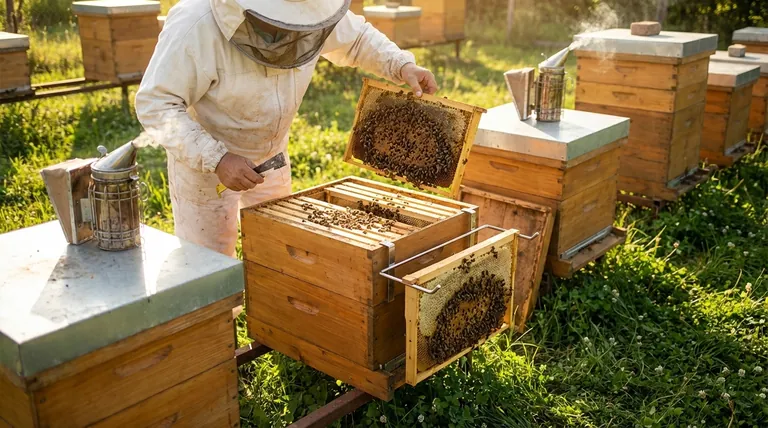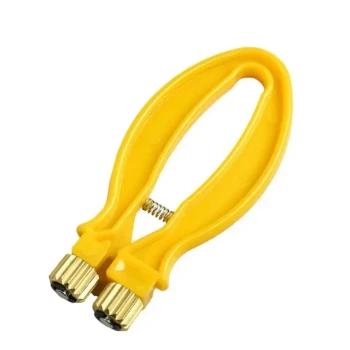In short, a frame perch is considered essential because it provides a secure, temporary holder for frames on the side of the hive during an inspection. By doing so, it prevents frames from being placed on the ground or leaned precariously, which can endanger the queen, chill the brood, and spread pests. This simple tool frees up your hands and transforms a potentially chaotic process into a safe and efficient workflow.
A hive inspection requires removing frames to create working space. Without a dedicated place to put them, you risk damaging the comb, losing your queen, or killing bees. A frame perch is the solution, creating an organized, secure, and professional workstation directly on the hive body.

The Core Problem: Managing Loose Frames
A hive inspection is a delicate operation. To properly examine the health of the colony, you must remove at least one frame to create enough space to work without rolling or crushing bees between adjacent frames.
The Challenge of the First Frame
The very first frame you pull is the most problematic. You need to set it aside to begin your inspection, but your options are limited and often risky.
The Dangers of Improvising
Without a dedicated tool, beekeepers are forced to improvise. Placing frames on the ground can chill or kill the sensitive brood, pick up pests like ants or small hive beetles, and risks the queen wandering off and getting lost. Leaning them against the hive is unstable; a slight bump can send the frame crashing down, killing bees and potentially damaging the comb.
How a Frame Perch Transforms Your Workflow
A frame perch is a simple metal bracket that hangs securely on the edge of the hive body. Its value far exceeds its simplicity by systematically solving the problems of managing loose frames.
It Creates a Secure, Dedicated Workspace
The perch provides a stable, off-the-ground rack to hang the first frames you remove. This keeps them safe, clean, and contained within the immediate hive area.
It Protects Your Bees and Brood
By keeping frames off the ground, you eliminate the risk of contamination from pests and prevent brood from getting chilled. Because the perch holds frames securely, it prevents them from falling, which can crush dozens of bees and anger the colony.
It Frees Your Hands for Inspection
This is a critical benefit. With frames safely hung on the perch, your hands are free to operate your hive tool, use a smoker, or brush bees aside. You are no longer juggling a heavy, bee-covered frame while trying to work, which reduces stress for both you and the bees.
It Improves Efficiency and Organization
A frame perch allows you to keep frames in the order you removed them. Returning frames to their original position is good practice for maintaining the hive's structure (e.g., keeping the brood nest consolidated). The perch makes this organizational step effortless.
Are There Any Downsides?
Objectively, the arguments against using a frame perch are minimal and are far outweighed by the benefits to hive health and beekeeper efficiency.
Cost vs. Benefit
Frame perches are inexpensive tools. The high value they provide in terms of safety, queen security, and workflow efficiency makes them one of the most cost-effective pieces of equipment a beekeeper can own.
A Matter of Established Habits
Some veteran beekeepers develop methods for balancing frames or working without a perch. However, for new beekeepers, a frame perch is invaluable for establishing safe and effective habits from day one. For experts, it remains a tool that simplifies and professionalizes the task.
Making the Right Choice for Your Apiary
A frame perch isn't just a convenience; it's a tool that promotes a higher standard of beekeeping.
- If your primary focus is safety and bee welfare: A frame perch is essential for preventing dropped frames, protecting the queen from being lost, and keeping brood safe from chilling or pests.
- If your primary focus is efficiency and ease of use: This tool is one of the best investments you can make to streamline inspections, reduce personal stress, and keep your hands free for the actual work.
- If you are a new beekeeper: A frame perch is critical for building good habits and making your first inspections far more manageable and successful.
This simple piece of metal elevates your hive inspection from a clumsy struggle to a controlled, professional procedure.
Summary Table:
| Key Benefit | Description |
|---|---|
| Protects the Queen | Prevents frames from being dropped or misplaced, avoiding the loss of the queen. |
| Prevents Brood Chilling | Keeps frames off the ground, protecting sensitive brood from cold and pests. |
| Improves Workflow | Frees up your hands, allowing for a more efficient and organized inspection process. |
| Enhances Safety | Securely holds frames, reducing the risk of crushing bees and damaging comb. |
Ready to upgrade your apiary's safety and efficiency?
As a trusted supplier for commercial apiaries and beekeeping equipment distributors, HONESTBEE provides high-quality, durable frame perches and other essential beekeeping supplies through our wholesale-focused operations. Our equipment is designed to help you protect your investment, streamline your workflow, and maintain the highest standards of hive health.
Contact our team today to discuss your needs and discover how our wholesale solutions can benefit your operation.
Visual Guide

Related Products
- Heavy-Duty Stainless Steel Clip-On Frame Perch
- Heavy-Duty T-Style Frame Perch
- Professional Drop-Style Hive Handles for Beekeeping
- Multi-Function Hive Tool with Integrated Hammer for Beekeeping
- HONESTBEE Classic Pry Bar Hive Tool with High Visibility Finish for Beekeeping
People Also Ask
- What is the purpose of the frame perch? A Game-Changer for Efficient Hive Inspections
- How many frames can the beehive frame perch hold? Organize Your Hive Inspections with Ease
- How does the frame perch ensure stability during use? Secure Your Hive Inspections with Physics-Driven Design
- How many frames can a frame perch hold? Optimize Your Hive Inspections with the Right Tool
- How does the frame rest benefit the beekeeper during hive inspections? Boost Efficiency & Protect Your Colony



















